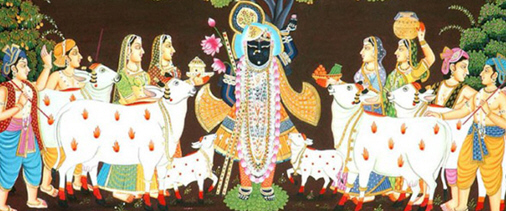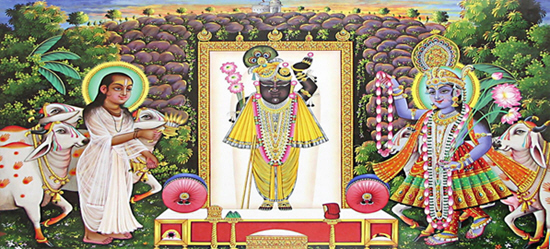
Another important part of seva is giving things to the Lord. In front of the temple early in the morning, you can buy milk, flowers, vegetables, and fruits and bring them into the temple to offer to the Lord. People also give lots of money. People also give ghee and grains. Most of the food prepared for the Deity is cooked in pure ghee. People give ghee in cans of ten, fifteen, or twenty kilos. Sometimes a whole train car full of ghee arrives in Nathdwara. The donor often prefers to stay anonymous. The shipment is simply marked, “From Srinathaji. To Srinathaji.”
The temple has a literal well of ghee. Cans of ghee are cut open and slightly heated, and the ghee is poured into the well. A pipeline extends from the well to the Deity’s kitchen ghee on tap. Ghee, of course, is expensive. But money is no bar in the worship of Srinathaji.
In the grain stockroom, everything is very orderly. All the grains that come in and go out are recorded. And when it goes out it goes only to the kitchen of Srinathaji. Nothing given is ever resold in the market. It’s all used in the service of the Lord.
The temple has many storerooms that pilgrims can see. One room is for keeping the Lord’s clothing and jewels. Another room, just opposite the temple, is called Sri Krishna Bhandar, “SriKåñëa’s Storeroom.” (It’s named after KåñëaDasa, the first manager of the temple.) This is the treasury and accounting office, and it’s where gold, pearls, saffron, and expensive clothing are kept.
There’s a room for flowers. There’s a tailoring room where clothes are sewn for the Lord. Another room holds gold and silver pots. There’s a rose room, where rosewater and rose scents are prepared. And there’s a room where books are on hand, spiritual teaching is given, and new publications are put out.
There’s a room for vegetables, a room for milk, cream, and butter, and a room for misri (rock sugar). There’s a grinding room for grinding grains (it’s still done with a big wooden mill, powered by bulls). Then there’s a room where the ingredients for the Lord’s meals are assembled before they are prepared and offered, and a room where offered food is kept just before it’s distributed.
No one goes hungry from here. The prasadam from the Deity is distributed profusely. A portion of the prasadam goes to the sevakas and temple workers, many of whom sell it. Right after the early-morning mangala-arati you’ll find püjaris standing just outside the temple, holding steel plates bearing clay cups full of different kinds of liquid milk sweets. Later in the morning, püjaris go around to hotels and dharmashalas with covered baskets full of varieties of prasadam to sell to pilgrims.
Apart from the püjaris, in the bazaar outside the temple you’ll find shops where you can buy prasadam, and pushcarts selling prasadam, and people sitting on the street selling prasadam.
In Caitanya-caritamrita, we find that the Deity Gopala, the same Deity known as Srinathaji, told Madhavendra Puri, “In My village, no one goes hungry.” Now, here in Nathdwara, where Gopala has come, we see that this is true. Even the street dogs here are fat. Prasadam is available all through the day, and in countless varieties different kinds at different times. After the midday raja-bhoga offering you can get a leaf-cup full of tasty vegetables for only one rupee (less than the cost of the ingredients themselves). You can get a leaf-cup of achar (pickle), again only a rupee. There are many kinds of chutneys, fruit salads, and a unique raita made with chopped fruit in thin yogurt spiced with mustard seeds. There are big chapatis full of ghee for two or three rupees, depending on the size. You’ll find rice, dal, curry sauce, fried vegetables, and samosas so huge that one is practically enough for a meal.
Then there are milk sweets and sweets made with grains and sugar, rich with ghee. You can buy big blocks of laddu, made with grain, ghee, and sugar, for a hundred rupees. Some sweets include such costly ingredients as musk and saffron. People don’t haggle much over prices. Whatever the shopkeepers say, people just accept it, and that’s all that.
Items like grain sweets and sugar-crusted fried puris keep for months without losing freshness. A pilgrim travelling abroad from Nathdwara may bring prasadam of Srinathaji to his friends overseas. Like the Deity Himself, the prasadam of Srinathaji is famous all over the world.



